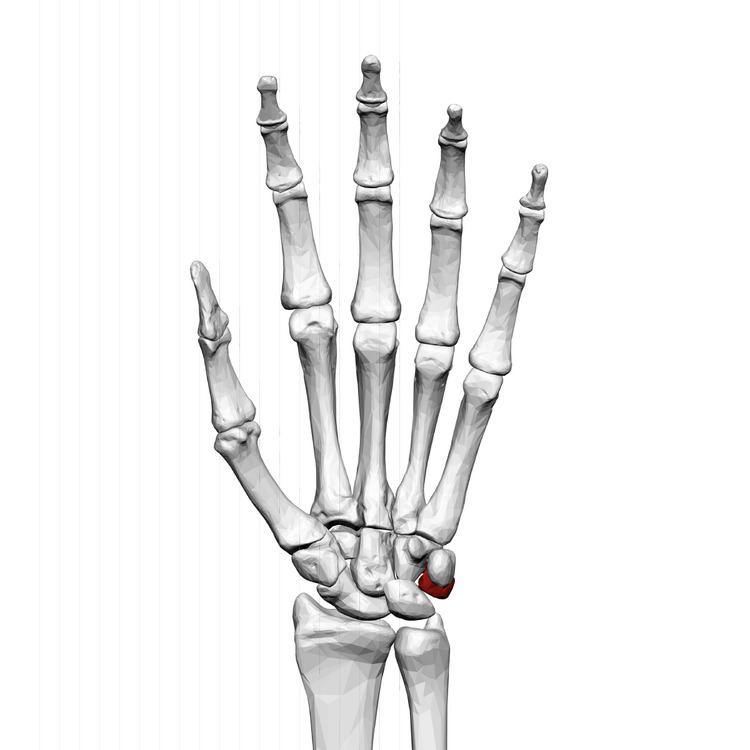Dorlands/Elsevier o_07/12598819 FMA 23715 | TA A02.4.08.006 | |
 | ||
Articulations articulates with three bones:lunate laterallypisiform in fronthamate distallytriangular articular disk which separates it from the lower end of the ulna. Latin os triquetrum, os pyramidale, os triangulare MeSH A02.835.232.087.319.150.831 | ||
The triquetral bone (/traɪˈkwɛtrəl/ or /traɪˈkwiːtrəl/; also called triquetrum, pyramidal, three-cornered or triangular bone, and formerly cuneiform bone) is located in the wrist on the medial side of the proximal row of the carpus between the lunate and pisiform bones. It is on the ulnar side of the hand, but does not articulate with the ulna. It connects with the pisiform, hamate, and lunate bones. It is the 3rd most commonly fractured carpal bone.
Contents
Structure
The triquetral is one of the eight carpal bones of the hand. It is a three-sided bone found within the proximal row of carpal bones. Situated beneath the pisiform, it is one of the carpal bones that form the carpal arch, within which lies the carpal tunnel.
The triangular bone may be distinguished by its pyramidal shape, and by an oval isolated facet for articulation with the pisiform bone. It is situated at the upper and ulnar side of the carpus. To facilitate its palpation in an exam, the hand must be radially deviated so that the triquetrium moves out from under the ulnar styloid process. The triquetrum may be difficult to find, since it also lies under the pisiform.
Ossification
The triquetral bone ossifies between 9 months and 50 months (4 years and 2 months).
Surfaces
The superior surface presents a medial, rough, non-articular portion, and a lateral convex articular portion which articulates with the triangular articular disk of the wrist.
The inferior surface, directed lateralward, is concave, sinuously curved, and smooth for articulation with the hamate. The dorsal surface is rough for the attachment of ligaments.
The volar surface presents, on its medial part, an oval facet, for articulation with the pisiform; its lateral part is rough for ligamentous attachment.
The lateral surface, the base of the pyramid, is marked by a flat, quadrilateral facet, for articulation with the lunate.
The medial surface, the summit of the pyramid, is pointed and roughened, for the attachment of the ulnar collateral ligament of the wrist.
In animals
In reptiles and amphibians, the bone is instead referred to as the ulnare, since (at least in the most primitive fossils) it articulates with the ulna.
Function
The carpal bones function as a unit to provide a bony superstructure for the hand.
Fracture
Triquetral fractures can occur due to forceful flexion of the wrist, causing an avulsion of the dorsal aspect of the bone that is often hidden on anterior radiographs, but can be seen as a tiny bone fragment on lateral views.
Etymology
The etymology derives from the Latin triquetrus which means "three-cornered."
